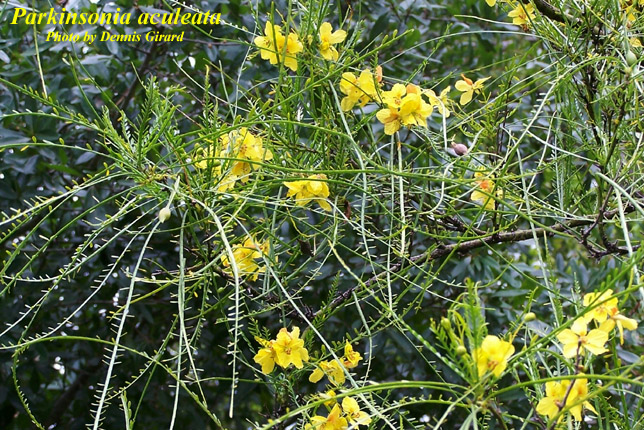Parkinsonia aculeata
| Parkinsonia aculeata | |
|---|---|

| |
| Photo by Dennis Girard, Atlas of Florida Vascular Plants | |
| Scientific classification | |
| Kingdom: | Plantae |
| Division: | Magnoliophyta - Flowering plants |
| Class: | Magnoliopsida – Dicotyledons |
| Order: | Fabales |
| Family: | Fabaceae ⁄ Leguminosae |
| Genus: | Parkinsonia |
| Species: | P. aculeata |
| Binomial name | |
| Parkinsonia aculeata L. | |

| |
| Natural range of Parkinsonia aculeata from USDA NRCS Plants Database. | |
Common names: Jerusalem thorn; Mexican Palo Verde
Contents
Taxonomic notes
Synonyms: none.[1]
Varieties: none.[1]
Description
P. aculeata is a thorny shrub with weakly papilionaceous flowers.[2] The leaflets are 1-5 mm long while the leaves are 2-pinnate and subsessile.[1]
Distribution
It is a native to Mexico but has spread and become naturalized in Florida.[3]
Ecology
Habitat
Habitats include grasslands, open woodlands, rangelands, pastures, waste areas, disturbed sites, roadsides, and near creeks.[4] It is adapted to life in the desert, by modified transpiration techniques and producing food with photosynthetic tissue in the bark.[5] Soil types include sandy loam, sand, clay, and loam. [6][7]
If growing in an over-irrigated spot, P. aculeata is susceptible to powdery mildew and root rot.[6]
Phenology
Flowers and fruits March through August.[7][8]
Seed dispersal
Seeds are dispersed by birds and other animals.[4]
Seed bank and germination
Seeds have a tegumentary dormancy which allows them to last a long time in seed banks until germination conditions are favorable.[9]
Pollination
The following Hymenoptera families and species were observed visiting flowers of Parkinsonia aculeata at Archbold Biological Station:[10]
Apidae: Apis mellifera
Colletidae: Hylaeus confluens
Megachilidae: Anthidiellum notatum rufomaculatum, A. perplexum, Anthidium maculifrons, Coelioxys germana, C. sayi, C. texana, Dianthidium floridiense, Dolichostelis louisae, Heriades leavitti, Megachile brevis pseudobrevis, M. exilis parexilis, M. frugalis, M. georgica, M. inimica, M. integra, M. mendica, M. petulans, M. policaris, M. rugifrons, M. texana
Sphecidae: Ectemnius rufipes ais
Vespidae: Polistes exclamans
Conservation and management
Cultivation and restoration
Photo Gallery
References and notes
- ↑ 1.0 1.1 1.2 Weakley, A.S. 2015. Flora of the southern and mid-atlantic states. Working Draft of 21 May 2015. University of North Carolina at Chapel Hill, Chapel Hill, North Carolina.
- ↑ Radford, A. E., Ahles, H. E., & Bell, C. R. (1968). Manual of the vascular flora of the Carolinas. Chapel Hill: University of North Carolina Press.
- ↑ [[1]] Pacific Horticulture. Accessed: February 17, 2016
- ↑ 4.0 4.1 [[2]] Accessed: February 16, 2016
- ↑ [[3]] Floridata. Accessed: February 16, 2016
- ↑ 6.0 6.1 [[4]] Accessed: February 16, 2016
- ↑ 7.0 7.1 Florida State University Robert K. Godfrey Herbarium database. URL: http://herbarium.bio.fsu.edu. Last accessed: October 2015. Collectors: Antonia Araiza, Robert Blaisdell, Kurt Blum, Ted Bradley, Richard Carter, Felipe Cisneros, J. Dwyer, Augustin Gamez, Robert K. Godfrey, James Henrickson, B.F. Meck, William R. Stimson, David W. Thompson, Edwin L. Tyson. States and Counties: Arizona: Maricopa. Florida: Dade, Leon, Pinellas. South Carolina: Beaufort. Texas: Live Oak, Victoria, Webb, Zapata. Countries: Costa Rica, Mexico. Compiled by Tall Timbers Research Station and Land Conservancy.
- ↑ Nelson, G. PanFlora: Plant data for the eastern United States with emphasis on the Southeastern Coastal Plains, Florida, and the Florida Panhandle. www.gilnelson.com/PanFlora/ Accessed: 19 MAY 2021
- ↑ Agra, PFM, et al. "Methods for Overcoming Dormancy of Parkinsonia Aculeata L. Seeds."SEMINA-CIENCIAS AGRARIAS36.3 (2015): 1191-202.
- ↑ Deyrup, M.A. and N.D. 2015. Database of observations of Hymenoptera visitations to flowers of plants on Archbold Biological Station, Florida, USA.